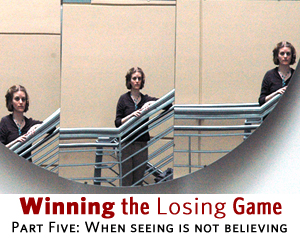Winning the Losing Game
Part five: When seeing is not believing

Writing about my effort to lose 19 pounds has led, predictably, to a good deal of self-reflection, particularly in the last few weeks, when the weight has stubbornly refused to leave. After shedding five pounds in five weeks, my progress has plateaued. I am now stuck at 150 pounds, and I am bummed — for two reasons. The first reason is a good one: I am failing in my quest, and failure hurts. The second reason is not: I fear that I will always look the way I look today, and the way I look today hurts even more.
Here’s a confession. For the past three months, I’ve practically lived in a zip-up, hooded sweatshirt because it’s my only article of clothing that adequately conceals my stomach. I know this is pathetic, but I also know I’m not the only person who struggles with her image. A recent survey by the American Society for Aesthetic Plastic Surgery says that 11.5 million cosmetic procedures totaling $12.2 billion were performed in the United States in 2006. And according to the Journal of the American Medical Association, Americans spend more than $33 billion annually on weight loss, including low-calorie foods and weight-loss clinic fees.
“Society has always placed a strong emphasis on body image,” says psychotherapist Joanne Pomodoro (SSW’99), a consultant in the BU Sports Psychology Services Center, who specializes in eating disorders among athletes. “During the Renaissance, the curvy, voluptuous woman was revered, but you’re not beautiful today unless you’re tall, thin, frail, and blonde — for all practical purposes, a supermodel.”
Pomodoro faults the fashion industry, television, and the media for skewering women’s perceptions of their bodies. “It starts at such a young age now,” she says. “Girls are dieting by the time they’re in second grade.”
Even Pomodoro, a five-time World Senior Champion racquetball player, buckled under the pressures of society’s beauty standards. Twenty years ago, she suffered from an eating disorder. “I was training too hard and not eating enough,” she says. “It was my way of punishing myself for not being ‘good enough,’ and I ended up in the hospital because of an irregular heartbeat.”
Current statistics about eating disorders suggest that Pomodoro was just a few years ahead of the crowd. The National Institute of Mental Health estimates that between 5 million and 10 million girls and women and a million boys and men suffer from eating disorders such as anorexia, bulimia, and binge eating. An additional 15 percent of young women have unhealthy attitudes and behaviors about food.
During my junior year of college, when I was fighting with my roommates, struggling academically, and ending my first serious relationship, I became so agitated that every time I ate, I threw up. I don’t like throwing up, so I simply stopped eating. I was miserable, I couldn’t concentrate, and by the time I went home in June, I had lost 15 pounds and dropped two clothing sizes. Thanks to my grandmother, who spent the summer cooking my favorite meals and holding me while I cried, I recovered. Every time I look at pictures from that year, I think, “Wow, I looked so thin and pretty!”
Now, when I reflect on that experience, I think how strange it is that the period of my life when I had the body I most admire was the period I was most screwed up, physically and emotionally. I contrast that with today, when I am physically fit (working out nearly every day) and emotionally sound (I’ve been in a healthy relationship for the past five years), yet have a body that I very much want to change. Clearly, there’s something wrong with the equation, and sadly, there’s no easy solution.
“The one thing to remember,” Pomodoro says, “is that while you can be your own worst enemy, you can also be your own best friend. We would never treat our friends the way we treat ourselves. We refuse to accept ourselves.”
For her, the journey to self-acceptance began with a nutritionist, a sports psychologist, and a therapist. “I had all of these distorted beliefs,” she recalls, “and I had to make peace with myself.”
There are a multitude of resources for women seeking help, she says. Support groups, therapy, and self-help books are all good places to start. And there’s also a big one: Pomodoro calls it simply communication.
“Communication — whether it be with others or with yourself — is key to overcoming body image issues,” she says. “There should be no shame in talking about it.”
For people who think that therapy is “too self-indulgent,” Pomodoro suggests looking at it as a coaching program. “Everybody needs someone on their team to provide support,” she says. “Think of it as a mentoring experience, rather than the dredging up of pain and bad memories.”
In my case, there isn’t a therapist, but there is a coach: my personal trainer Stephanie McNamara (SED’07). She knows how hard I have worked, she knows the progress I’ve made, and she lets me know, again and again. Her efforts are helping my head as much as helping my body. I am moving, I am moving. I am getting there.
Look for Vicky’s next installment on April 17, 2007.
Two months ago, BU Today writer Vicky Waltz began chronicling her four-month fitness challenge. Click here to read the first installment, “One woman’s four-month fitness challenge.” Click here to read the second installment, “After an injury, changing the game.” Click here to read the third installment, “Calories in vs. calories out.” Click here to read the fourth installment, “Glimpsing the gain.”
Vicky Waltz can be reached at vwaltz@bu.edu.
Joanne Pomodoro can be reached at jpomodoro@alum.bu.edu.